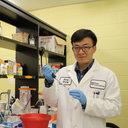[Microsurgical treatment of nonmeningeal tumors of the cavernous sinus].
Түлхүүр үгс
Хураангуй
OBJECTIVE
To analyze the differential diagnosis of and effectiveness of surgical treatment on nonmeningeal tumors of cavernous sinus.
METHODS
The clinical data, including clinical manifestations, diagnosis and differential diagnosis, operative procedure, and treatment results of 67 cases of nonmeningeal tumors of cavernous sinus, 32 males and 35 females, aged 41 +/- 16, who underwent microsurgical treatment were analyzed respectively.
RESULTS
The main clinical presentation included cranial nerve paralysis (47 cases, 70.1%), neuroendocrine symptoms (11 cases, 16.4%), eye pain (9 cases, 13.6%), proptosis (7 cases, 10.6%), limb weakness (5 cases, 7.5%), headache, dizziness, lethargy, and temporal lobe epilepsy (4 cases each), and epistaxis (1 case). All patients had CT and/or MRI scanning before operation. Twenty-six patients had DSA examination and balloon occlusion test (BOT). All patients underwent orbito-zygomatico-pterional craniotomy. Twenty cases were operated on via intradural approach, 33 cases via epidural approach, and 14 cases via epidural/intradural combination approach most of which suffered from invasive pituitary adenoma and dumbbell type trigeminal neurinoma. Pathological examination revealed that hemangioma (24 cases), trigeminal schwannoma (18 cases), and invasive pituitary adenomas (11 cases) comprised the majority of tumors; the remaining tumor types were chordoma, chondroma, chondromyosarcoma, chondrofibroma, dermoid tumor, malignant nerve sheath tumor, metastatic tumor, and lymphoma. In the intradural approach group, total tumor removal was achieved in 8 cases (40%), and 7 (35%) cases and 5 (25%) cases had subtotal and partial resection respectively. In the epidural approach group, 27 cases (81.8%) had total tumor removal, while 1 case (3.0%) had subtotal and 5 cases had partial excision of the tumor. In the epiduro-transdural approach group 10 cases (71.4%) achieved total resection and 4 cases (28.6%) had subtotal resection. Postoperative follow-up lasting 6 months to 10 years showed that the pre-operative central nervous system symptoms recovered in 39 cases (58.2%). The aggressive or new symptoms mainly included paralysis of oculomotor nerve (13 cases, 19.4%), trigeminal nerve (9 cases, 13.4%), and abduct nerve (9 cases, 13.4%).
CONCLUSIONS
Depending on pathologic type and growth pattern of the tumor, extended middle skull base epidural or epidural-transdural approach is selected. Such techniques can offer satisfactory outcome, protecting the cranial nerve functions and removing the tumor to the maximum extent.



